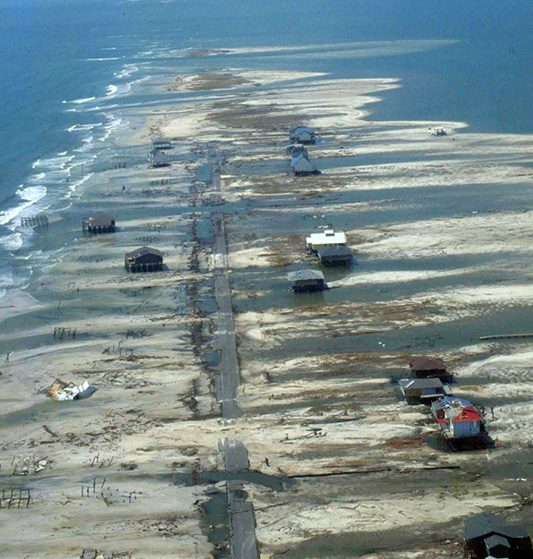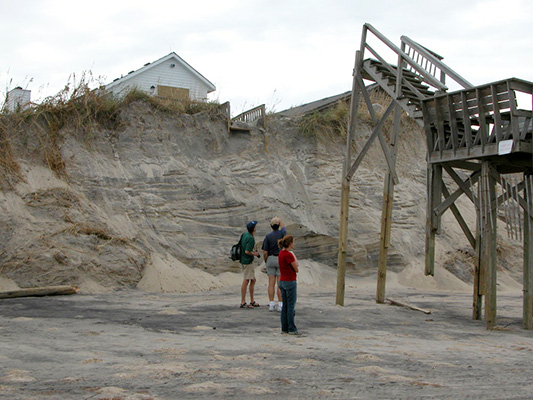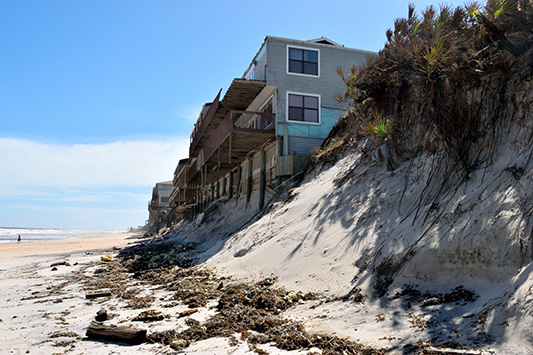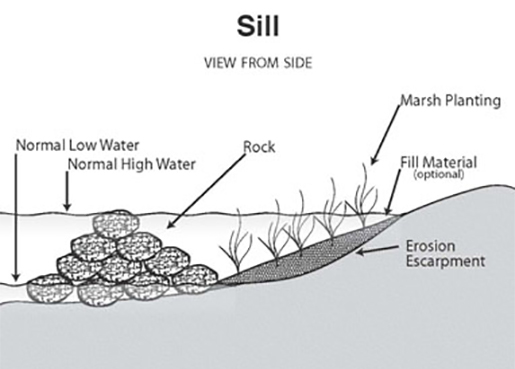Southeast Project Resources:

Beach-building (accretion) and erosion are natural processes. The desire to live and build structures on our coastlines exposes our homes, roads, commercial and industrial facilities, shipping ports, marinas, and other buildings to shoreline erosion.
Why do we care about the erosion along our coasts?
Our coastlines are currently home to 40% of the U.S. population. There is a long trend of higher growth on the coasts. The coastal area of the U.S. is twice as developed as the rest of the country: 8.8%, versus 4.09% of the interior.
As global sea level rises, wave action and storm surge increase the likelihood of extensive coastal erosion. It is estimated that coastal erosion currently costs roughly $500 million per year for U.S. coastal property loss, including damage to structures and loss of land. As our climate continues to change, the increasing frequency of extreme weather threatens our shoreline communities.

Our coastlines are currently home to 40% of the U.S. population. There is a long trend of higher growth on the coasts.

The coastlines of North Carolina, South Carolina, Georgia, and eastern Florida are known for their sandy beaches and warm waters. A popular destination for vacationers and fishermen alike, the Southeast represents the fastest-growing coastal region in the U.S.
This rapid development has brought about environmental changes that threaten native ecosystems and the oceanfront economy. An influx of tourists and permanent residents has increased regional pollution, and the demand for beachfront construction has damaged or destroyed some of the region’s vital reefs and marshes. Ports and channels used for overwater transit disrupt the natural tidal flow, causing nutrients, pollutants, and sediment to settle in low-lying pockets that must be dredged. With the demand for development remaining steady, it is critically important that the natural structures that mitigate beach erosion be preserved and replenished.
Since the 1980s, the booming construction of private residences, businesses, and industries along the southeastern shoreline has taken its toll on the native ecosystem. The soft sand that makes up the region’s famous barrier islands and shoals is easily displaced by human activity. Sand mining, the process of removing beach sand to allow for oceanfront construction, has eroded the buffer that formerly protected coastline property from tidewater and storm surges. As global sea levels rise, beachfront developments are increasingly at risk.
Beyond the threats introduced by higher tide lines, warming ocean temperatures and elevated atmospheric carbon dioxide have triggered changes in the ocean’s pH that threaten the marine life that anchors shorelines and buffer surging waves. While traditional solutions, like bulkheads and seawalls, may slow the disappearance of the region’s beaches, they don’t address the loss of habitat that precipitates future erosion. Restoring our natural shorelines not only protects homes and businesses from beach erosion, it also rebalances the ecosystems that are integral to maintaining the health and beauty of our southeastern coast.


Where it is feasible, returning our coastal estuaries and shoreline to a natural, undeveloped state can increase the resilience to storms, flooding, erosion, and other threats to these communities. Coastal wetlands are well known to be natural sponges that absorb floodwaters, putting the brakes on destructive wave action, and mitigating coastal erosion. Natural shorelines buffer storm surges, sequester carbon and other pollutants, and support a healthy habitat for commercially and recreationally important fish species.
Living shorelines, soft shore protection, Green Shores for Homes, and other hybrid approaches are nature-based solutions to coastal erosion that can mimic nature while protecting your property and increasing critical habitat for marine species. Coastal restoration projects may replace a seawall or bulkhead with a natural beach, soft shore protection, salt marsh bordered by an oyster reef, or similar structure. One study found that living shorelines removed more than 50% of nitrogen from the water, and more was removed as sites matured.
Living shorelines are natural solutions to coastal erosion.

Protecting coastal communities has become increasingly important as the population grows and sea levels rise. However, shoreline hardening has harmful impacts on wildlife and fish habitat. One study found that seawalls supported 23% lower biodiversity and 45% fewer organisms than natural shorelines.
Soft shore protection, or living shorelines, is a natural approach to reduce erosion and flooding, while also creating or maintaining habitat. Living shoreline projects may replace a seawall or bulkhead with a natural beach, soft shore protection, salt marsh bordered by an oyster reef, or similar structures.
One study suggested that marshes protect shorelines from erosion better than bulkheads. It found that Hurricane Irene damaged 76% of bulkheads surveyed, while very little or no damage was found in marshes protected by living shorelines.
If you live on the shoreline, you will find a softer shoreline to be more beautiful and resilient than a bulkhead. They are also much cheaper to install and maintain than hard structures such as bulkheads and seawalls. Living shorelines are often more effective if they stretch along an entire beach rather than just one property. Consider connecting with your neighbors to build living shorelines. If you do not live on the shoreline, consider volunteering to help with projects to restore coastal areas, such as planting marsh grasses and removing invasive plants.
A marsh sill is a type of low-profile stone structure used to contain sand fill to create a newly planted marsh that dissipates wave energy so that the marsh can establish and help reduce erosion farther inland.

North Carolina Environmental Quality

Volunteers restore mangroves along the shoreline.
We need your help to improve the Toolkit by completing our easy, 3-minute survey. Your insight is valuable to us.